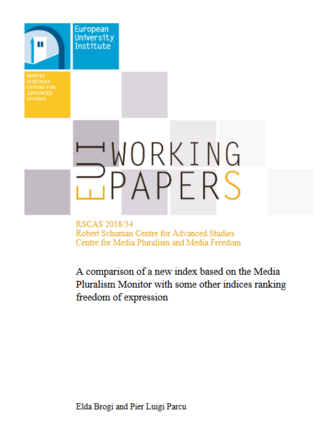
Since 2013, the Centre for Media Pluralism and Media Freedom (CMPF) at the European University Institute (EUI) has annually assessed and scored the risks to media pluralism and media freedom in EU member states and some candidate countries using a complex measuring tool, the Media Pluralism Monitor (MPM). The paper uses the MPM results 2016, published in 2017, and the findings of Reporters without Borders and Freedom House published in 2017.
The four scores (Basic Protection, Market Plurality, Political Independence, and Social Inclusiveness) are averaged to propose a new “ranking” of the risk to media pluralism in the countries examined by the MPM.
The paper assesses these four areas by scoring 20 indicators and 200 variables in total. The indicators cover a broad notion of media pluralism that encompasses political, cultural, geographical, structural, and content-related dimensions. The working paper covers all types of media: public service, commercial, community media, new media, and online platforms. The MPM methodology relies on a sophisticated questionnaire completed by MPM teams consisting of national country experts and external experts, including national stakeholders and area experts.
The paper states that the methodology used for the Media Pluralism Monitor differs from the methodologies used by Reporters without Borders and Freedom House, which are more similar to each other in compiling the rankings on freedom of expression. According to the paper, the MPM uses very high benchmarks and thresholds in line with the standards expected in the EU, while FH and RWB tools were created to analyse the situation of freedom of expression and media pluralism worldwide. However, the legal theoretical framework looks very similar, as it is based on international standards for freedom of expression.
The paper argues that, being limited to the EU and candidate states, the MPM can rely on homogeneous datasets on some specific topics and on a common legal framework. According to a preliminary statistical analysis, the MPM results related to the common exogenous factors, like the country’s population or the GDP per capita, are easier to understand and less biased than the others.
Tags: Freedom of expression Media pluralism Media freedomThe content of this article can be used according to the terms of Creative Commons: Attribution-NonCommercial 4.0 International (CC BY-NC 4.0) . To do so use the the wording "this article was originally published on the Resource Centre on Media Freedom in Europe" including a direct active link to the original article page.

